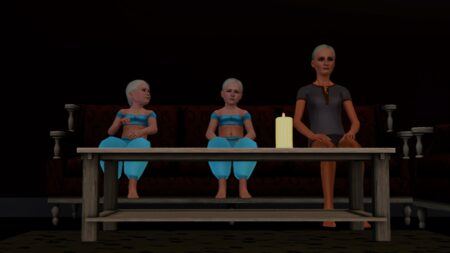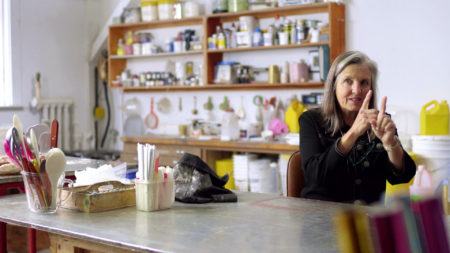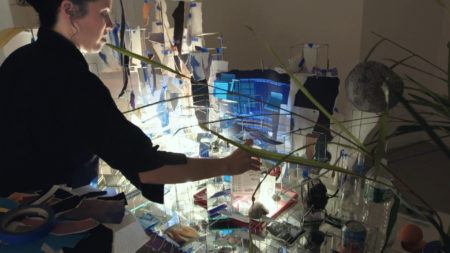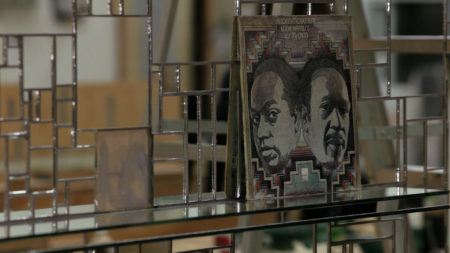Continue playing
(Time remaining: )
Play from beginning
Continue playing "{{ controller.videos[controller.getVideo(controller.currentVideo)].segmentParentTitle}}"
{{controller.videos[controller.getVideo(controller.currentVideo)].title}} has ended.
Adam Milner Takes Care of the Details
Visit our Awards page for this film’s honors and recognition.
What can the little things tell us about the big things? From flower petals to eyelashes, plastic gemstones, a friend’s hair or Babybel cheese wax casing, artist Adam Milner mixes and matches a range of overlooked, but deeply resonant objects into artworks that explore our often fraught relationships with the things that fill our lives. Identifying as a collector and arranger of objects, Milner works primarily at home in Brooklyn, New York, intentionally intermingling the creative process with the items, spaces, and rituals of domestic private life. Self-consciously working against the grain of popular home decor shows like Tidying Up with Marie Kondo and Hoarders and their stigmatization of household objects, Milner says, “A lot of these philosophies are about getting rid of things, but I’m really interested in this idea of vibrant matter…that everything is active and when we’re done with something, it still exists in the world.”
As part of the artist’s regular practice, Milner visits a neighborhood thrift shop and The Metropolitan Museum of Art, observing the varying levels of care and categorization each space brings to its objects. Artworks and functional items are sold side by side at the thrift shop, their cultural and economic distinctions flattened in a cozy sprawl. The museum attempts to create a more idealized theatre of display, carefully highlighting rare individual works, but disappearing the brackets and hardware that uphold them. For Milner, the jump from home to retail space to curated museum is an on-going lesson in the malleability of cultural values and hierarchies.
For the 2021 exhibition Public Sculptures, produced through the nomadic museum Black Cube, Milner draws upon these lessons and creates new contexts for audiences to access and understand art. The artist installs carefully calibrated sculptures—a conch shell with a metal filled interior and a tableaux of costumed deer figurines—in public spaces like a neighborhood bodega and friend’s car. “Everything is porous and everything is always absorbing the thing next to it,” says Milner. “If it’s confusing where things begin and end, it’s a lot harder to divide and segment. I’m always trying to resist the clean category.”
Credits
New York Close Up Series Producer: Nick Ravich. Director & Producer: Lorena Alvarado. Editor: Lorena Alvarado. Cinematography: Demi Waldron. Additional Camera: Sean Hanley. Sound: Mariya Chulichkova. Sound Design & Mix: Gisela Fullà-Silvestre. Color Correction: Addison Post. Design & Graphics: Chips. Music: Cloud and Raw Paws. Artwork Courtesy: Adam Milner. Thanks: Black Cube, Hannah James, Alexandra Kozlakowski, Restoration Worship Temple, Second-hand Shop, Rebecca Schear, Cortney Lane Stell, The Metropolitan Museum of Art, and Two Ways Supermarket.
New York Close Up is supported by The Andy Warhol Foundation for the Arts; and, in part, by public funds from the New York City Department of Cultural Affairs in partnership with the City Council; Dawn and Chris Fleischner; and by individual contributors.
Digital exhibition of New York Close Up films is made possible in part by the New York State Council on the Arts.
Closed captionsAvailable in English, German, Romanian, Italian, Japanese, Korean, Chinese, Italian
Through the Art21 Translation Project, multilingual audiences from around the globe can contribute translations, making Art21 films more accessible worldwide. Translate this video now.
Interested in showing this film in an exhibition or public screening? To license this video please visit Licensing & Reproduction.
Adam Milner was born in 1988 in Denver, Colorado, and lives and works in Brooklyn, New York. The artist received a BFA from the University of Colorado and an MFA from Carnegie Mellon University. Working across sculpture and installation, Milner investigates and recontextualizes the objects of the home, the hoard, the museum, and the body, questioning the boundaries and hierarchies that rule these domains.
“I’m really interested in this idea of vibrant matter or this idea that everything is active—and how when we’re done with something, it still exists in the world.”
Adam Milner
Found Objects
Liz Magor
Sarah Sze




